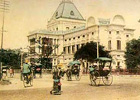 |
Top Destinations |
|
|
|
 |
Travel Tools |
|
|
|
 |
|
|
History of Singapore - culture and background country
 The earliest known mention of Singapore was a 3rd century Chinese account
which described Singapore as "Pu-luo-chung" ("island at
the end of a peninsula"). Little is known about the island's history
at that time but this matter-of-fact description belies Singapore's colourful
past.
The earliest known mention of Singapore was a 3rd century Chinese account
which described Singapore as "Pu-luo-chung" ("island at
the end of a peninsula"). Little is known about the island's history
at that time but this matter-of-fact description belies Singapore's colourful
past.
By the 14th century, Singapore had become part of the mighty Sri Vijayan
empire and was known as Temasek ("Sea Town"). Located at the
natural meeting point of sea routes at the tip of the Malay Peninsula,
Singapore had long known visits from a wide variety of sea craft, from
Chinese junks, Indian vessels, Arab dhows and Portuguese battleships to
Buginese schooners.
During the 11th century, this small but strategically-placed island had
earned a new name - "Singa Pura" ("Lion City"). According
to legend, a visiting Sri Vijayan prince saw an animal he mistook for
a lion and Singapore's modern day name was born.
The British provided the next notable chapter in the Singapore story.
During the 18th century, they saw the need for a strategic "halfway
house" to refit, feed and protect the fleet of their growing empire,
as well as to forestall any advances by the Dutch in the region.
It was against this political backdrop that Sir Stamford Raffles established
Singapore as a trading station. The policy of free trade attracted merchants
from all over Asia and from as far afield as the US and the Middle East.
By 1824, just five years after the founding of modern Singapore, the
population had grown from a mere 150 to 10,000.
In 1832, Singapore became the centre of government for the Straits Settlements
of Penang, Malacca and Singapore. The opening of the Suez Canal in 1869
and the advent of telegraph and steamship increased Singapore's importance
as a centre for the expanding trade between East and West.
Singapore had been the site of military action in the 14th century when
it became embroiled in the struggle for the Malay Peninsula between Siam
(now Thailand), and the Java-based Majapahit Empire.
Five centuries later, it was again the scene of significant fighting during
World War II. Singapore was considered an impregnable fortress, but the
Japanese overran the island in 1942. After the war, Singapore became a
Crown Colony. The growth of nationalism led to self-government in 1959
and on 9 August 1965, Singapore became an independent republic
Reference
: www.Visitsingapore.com
|
|
 |
Travel
Guides |
|
|
 |
|

